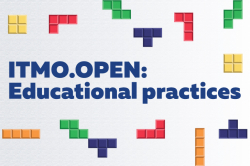According to Alexandra Gadenova, the deputy head of ITMO’s Open Education Department, all three programs are essentially a number of interconnected courses offered by experienced lecturers, which would allow students to gradually boost their skills and knowledge. Alexandra believes that opting for such comprehensive programs will be more efficient for students than building their own learning tracks from the multitude of stand-alone online courses from scratch. This second approach goes hand in hand with the risk of losing time on bad-quality material or having to learn something you already know.
“Another benefit of the university’s programs is continuous student support and a personal approach to students’ needs: the programs feature Telegram groups, Zoom consultations, feedback on homework assignments, as well as recommendations from teachers,” adds Alexandra. “What’s more, students in online courses usually only get a certificate of their completion, however, in our case we offer a state-standard CPD certificate. Employers value such official certifications that can prove a certain skill set of a candidate or current staff member seeking a promotion. For instance, one of our students was promoted after they submitted their certificates to their employer.”
Data Analysis

Credit: depositphotos.com
Gigantic amounts of information are produced every minute and companies from almost every sector of the economy rely on it in their work. However, this data needs to be deciphered, analyzed, and interpreted in order to be used. And that’s the responsibility of data analysts.
At the Data Analysis online program, students guided by experienced lecturers and practitioners will learn to collect, generalize, and structure information, so that later they can visualize it to build their hypotheses on how to improve various business processes. Students will work with summary tables and databases, as well as learn the basics of statistics and probability theory.
According to the authors of the program, even those with no prior experience or knowledge in the field will be able to acquire sought-after and highly-paid skills in IT. On the other hand, practicing data analysts will get the chance to improve their qualifications.
“I work at a web development company. The company happened to launch a department on blockchain and exchange analytics. As I started working, I realized that I needed to brush up my theory because I am actually trained in a slightly different field, I am a developer. So the Data Analysis program matched my needs perfectly. It was easy to interact with the website: first, you watch videos on theory, then see it applied, and complete the tasks based on these examples. I liked that there were lots of links to additional sources. Once a week, we could also talk to the lecturers to discuss any challenging tasks or ask questions – you would typically have to do it on your own in the majority of free courses. Some topics were harder, some – a little easier, but even given my experience in the field, I still found something new or got the chance to confirm my knowledge,” says Denis Udot, a student of the program.
The program is offered on the Open Education platform, where students access lectures and personal assignments based on real-life cases, as well as feedback on their completed tasks. Moreover, twice a week the lecturers host online workshops in Zoom. Additionally, there are Telegram groups, where students can talk to each other and their mentors. The program also features HR consultations on career development, as well as meetings with employers, such as VK, DigitalDes, and Manychat where they can learn about actual data analysis tasks solved in the industry.

Elena Mikhailova. Photo by ITMO.NEWS
“Data analysts are in high demand – they are usually employed before they even get to complete the course. This is all thanks to the fact that even during their training our students get to solve real-life cases, fulfilling tasks that are almost identical to those they would have to do at their jobs,” comments Elena Mikhailova, the head of the program and director of ITMO’s Higher School of Digital Culture.
You can learn more about the program here (in Russian).
Project Development with BIM
BIM or Building Information Modeling is a building modeling technology that allows specialists to collect, process, and adjust large amounts of data that appears during design, construction, and use of a building. As a result, one digital model contains all information about an object.
Such models are developed with Autodesk Revit and Navisworks, which students of the program will learn to apply on various stages of designing construction objects. Moreover, students will work with project documentation and automate various processes, such as BIM, blueprint creation, and workload management.
“In order to be able to develop building information models, students will have to install the relevant software that we will provide for free. They won’t need a powerful computer to successfully run it,” says Filipp Perepelitsa, director of ITMO’s International Research and Education Center Autodesk.

Filipp Perepelitsa. Photo by ITMO.NEWS
The program will be useful for fledgling architects, designers, or engineers, as well as specialists from related fields or experienced designers.
As part of their studies, each student will develop their own project and receive feedback and career advice from lecturers and coordinators.
Registration for the program is currently closed, but you can sign up to the newsletter to be notified about the date of the next launch here (in Russian).
Professional Web Design in HTML and CSS
Web designers are responsible for correctly arranging text, pictures, buttons, and other elements on a webpage. They are the ones turning a mock-up design into code and creating the visual interface of the website.
This can be accomplished with HTML and CSS – which are the two languages students will learn in this course. They will be able to do semantic, expressive, and accessible HTML design, export graphics and element characteristics, create visual effects, and work with Figma.
Mastering these skills will help students start out on their path in IT. Those looking to grow into a front-, back-end, or React developer will be able to get the skills needed for further professional development. Specialists in related fields, such as IT managers and designers, will get the chance to learn how web interfaces work.

Credit: depositphotos.com
Step-by-step demonstrations and examples of solutions will help students get a better understanding of the material, while interactive simulators will make it possible to fully engage with practical tasks. After completing each module of the program, students will solve tasks and then receive expert feedback on their solutions.
“Truly interactive learning materials are the main benefit and standout feature of the program. They will basically help students write their own code, as well as understand and experiment with that written by others. If you want to start programming, watching videos won’t get you there – you need to code. What’s more, at the program students will work on actual cases with their mentors, who are experienced front-end developers. This way, it’s possible to learn the key skill – to think like a professional and decide how better to implement a task,” explains Alexander Pershin, CEO of the LLC Interactive Educational Technologies.
You can sign up for the program here (in Russian).





